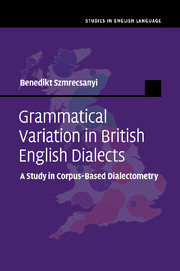Book contents
- Frontmatter
- Contents
- List of figures
- List of maps
- List of tables
- Preface and acknowledgments
- 1 Introduction
- 2 Data and methods
- 3 The feature catalogue
- 4 Surveying the forest: on aggregate morphosyntactic distances and similarities
- 5 Is morphosyntactic variability gradient? Exploring dialect continua
- 6 Classification: the dialect area scenario
- 7 Back to the features
- 8 Summary and discussion
- 9 Outlook and concluding remarks
- Appendices
- References
- Index
1 - Introduction
Published online by Cambridge University Press: 05 December 2012
- Frontmatter
- Contents
- List of figures
- List of maps
- List of tables
- Preface and acknowledgments
- 1 Introduction
- 2 Data and methods
- 3 The feature catalogue
- 4 Surveying the forest: on aggregate morphosyntactic distances and similarities
- 5 Is morphosyntactic variability gradient? Exploring dialect continua
- 6 Classification: the dialect area scenario
- 7 Back to the features
- 8 Summary and discussion
- 9 Outlook and concluding remarks
- Appendices
- References
- Index
Summary
In short, this book explores how and to what extent morphosyntactic variability in traditional British English dialects is structured geographically. Taking an interest in the forests rather than in individual trees, the study is concerned with aggregate dialectal (that is, morphosyntactic) variability among the measuring points investigated. We address this variability by establishing text frequencies of dozens of morphosyntactic features in a major naturalistic dialect corpus that covers dialect speech in over thirty counties all over Great Britain. Utilizing state-of-the-art dialectometrical analysis methods and visualization techniques, the study is original both in terms of its fundamental research question (“What are large-scale patterns of grammatical variability in traditional British English dialects?”) and in terms of its methodology (CORPUS-BASED DIALECTOMETRY).
Rationale, method, and objectives
The study proceeds from the fact that we know next to nothing about aggregate morphosyntactic variability in British English dialects. While it is known that “every corner of the country demonstrates a wide range of grammatically non-standard forms” (Britain 2010, 53), we note that the bulk of the literature on dialect grammar consists of atomistic single-feature studies, and the handful of studies that have taken an aggregate approach typically focus on lexis and, in particular, phonology, but not morphosyntax. In this connection, it should also be noted that there is an oft-implicit notion in large parts of the dialectological community that morphological and (particularly) syntactic variation is not really patterned geographically.
- Type
- Chapter
- Information
- Grammatical Variation in British English DialectsA Study in Corpus-Based Dialectometry, pp. 1 - 14Publisher: Cambridge University PressPrint publication year: 2012
- 1
- Cited by

